When the pandemic hit, the ad industry suddenly became paralyzed. Then, just as brands started to find their footing again, Black Lives Matter protests broke out, exposing the deep cracks of systemic racism in everyday American life. Brands responded with statements, donations, a blackout and a Facebook boycott. Consumers demanded action. All the while, Procter & Gamble (P&G) kept a low profile for what the company’s chief brand officer Marc Pritchard says was an intentional display of action, not headlines.
During his Cannes Lions presentation on LIONS Live, Pritchard explained P&G’s behind-the-scenes response to COVID-19, the anti-racism protests and gender inequalities exacerbated by the pandemic. In addition, he shares the racial equality roadmaps P&G brands will follow as an example of how brands can use creativity to lead change.
P&G’s pandemic game plan began with a review of every communication through the lens of being useful. In addition to creating how-to content such as cutting hair at home and skincare after wearing a mask all day, P&G donated products, money and personal protective equipment to families in need through over 200 relief organizations worldwide.
In response to a request from Ohio governor, Mike DeWine, to help encourage young people to social distance, P&G enlisted TikTok mega-influencer Charli D’Amelio, who has 65.9 million followers, to create the #DistanceDance challenge. P&G pledged to donate products to families in need for the first 3 million videos that remixed the challenge. The challenge went viral: 3.4 million users created their own version of the dance and D’Amelio’s video has been viewed 16.9 billion times since. P&G, however, didn’t make its involvement explicit.
P&G also launched programs and campaigns aimed at supporting hard-hit communities such as women and BIPOC (Black & Indigenous People Of Color). One such initiative included the re-release of a film P&G first launched in 2019 called “The Look,” designed to highlight the racial bias black men face every day.
Having never dealt with inequality issues in race, healthcare and gender, many brands are willing to initiate change but don’t know where to start. Pritchard recommends taking the time to learn about the history of racism and having difficult conversations to induce understanding, empathy and action.
To continue its anti-racism efforts, P&G has set a goal of achieving 40 percent multicultural representation within P&G North America. It also plans to increase investment in black-owned or operated media companies, agencies and marketing suppliers. A comprehensive review to ensure P&G advertising “accurately and respectfully portrays black people and all people” is also underway. Lastly, P&G is ensuring that it’s not advertising on or near discriminatory content.

